Complete Solutions to Transport In Plants of chapter TRANSPORT IN PLANTS of Class 11 book with complete answers and questions
| Class 11 | BIOLOGY |
| Chapter | TRANSPORT IN PLANTS |
| NCERT FINGERTIPS | Transport In Plants |
| Number Of Questions | 100 |
| Academic Year | 2023-24 |
Statement 1: the process of diffusion does not require any input of energy.
Statement 2: Diffusion involves movement of particles from a region of higher concentration to a region of lower concentation.03:00View SolutionMovement of the molecules of solids, gases or liquids from the region of their higher concentration to the region of their lower concentration is known as
01:11View SolutionThe process of diffusion is involved in
01:00View SolutionThe type of diffusion in which substances move across the membrane along their concentration gradient in the presence of certain carriers or transport proteins is called as
01:24View SolutionFacilitated diffusion
01:38View SolutionSelect the incorrect statement regarding facilitated diffusion.
01:36View SolutionRefer to the given figure. What does it represent?
 01:08View Solution
01:08View SolutionWhen transport proteins simultaneously move two molecules across a membrane in the same direction ,the process is called
01:22View SolutionIn passive transport across a membrane, when two protein molecules move in opposite direction it is called as
04:10View SolutionThe given figure shows transport of two molecules `A` and `B` through three different modes of facilitated diffusion. Select the correct option regarding it.
 02:09View Solution
02:09View SolutionSmaller, lipid soluble diffuse fater through cell membrane, but the movement of hyfrophilic substances is facilitated by certain transporters which are chemically
01:53View SolutionActive transport
02:10View SolutionUphill transport `I.e.` movement of substances from their lower concentation to their higher concentration occurs in
02:56View SolutionRefer to the given figure and identify `P,Q,R` and `S`.
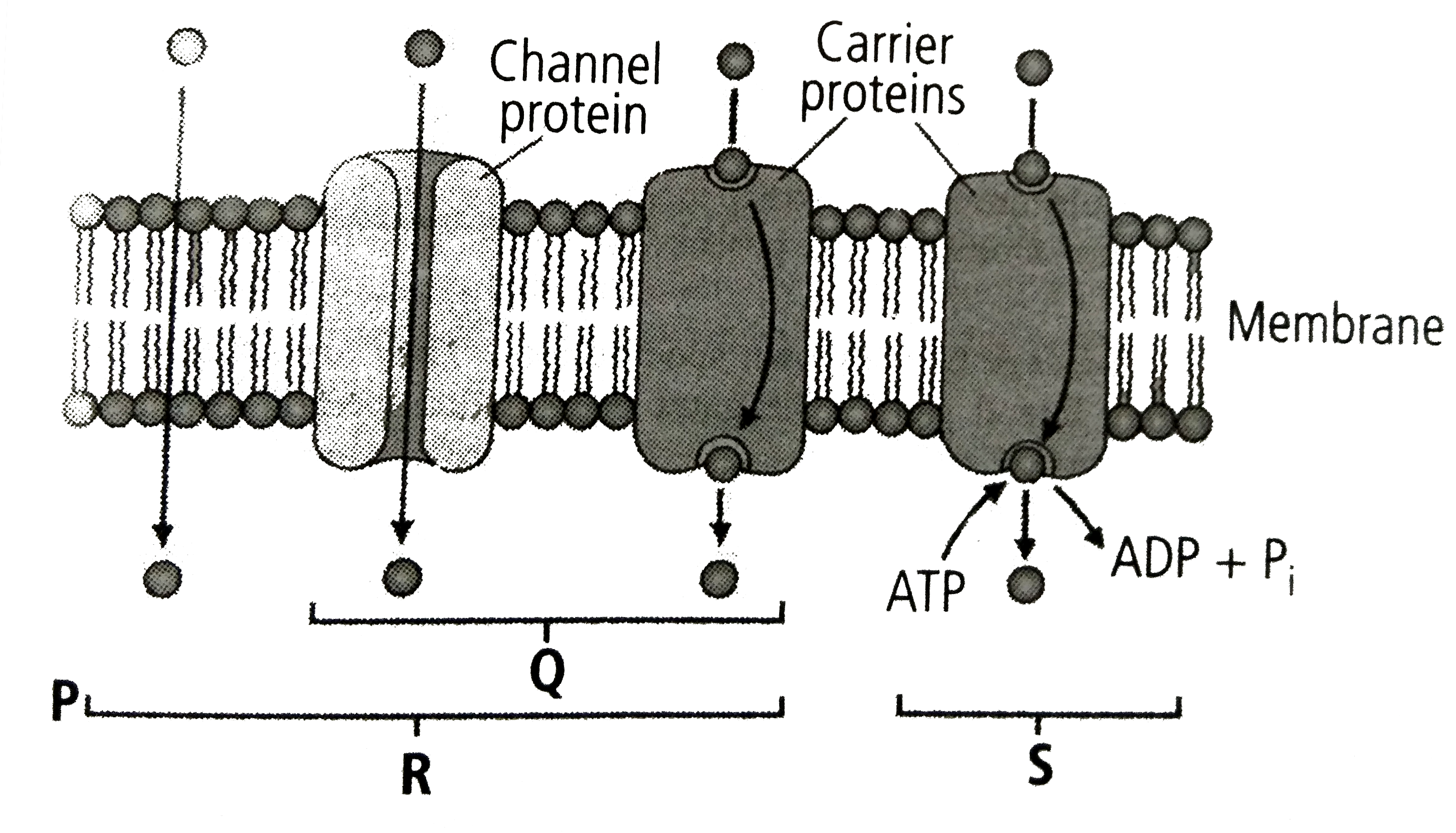 04:30View Solution
04:30View SolutionRefer to the given table and select the option that correctly fills the blanks in it.
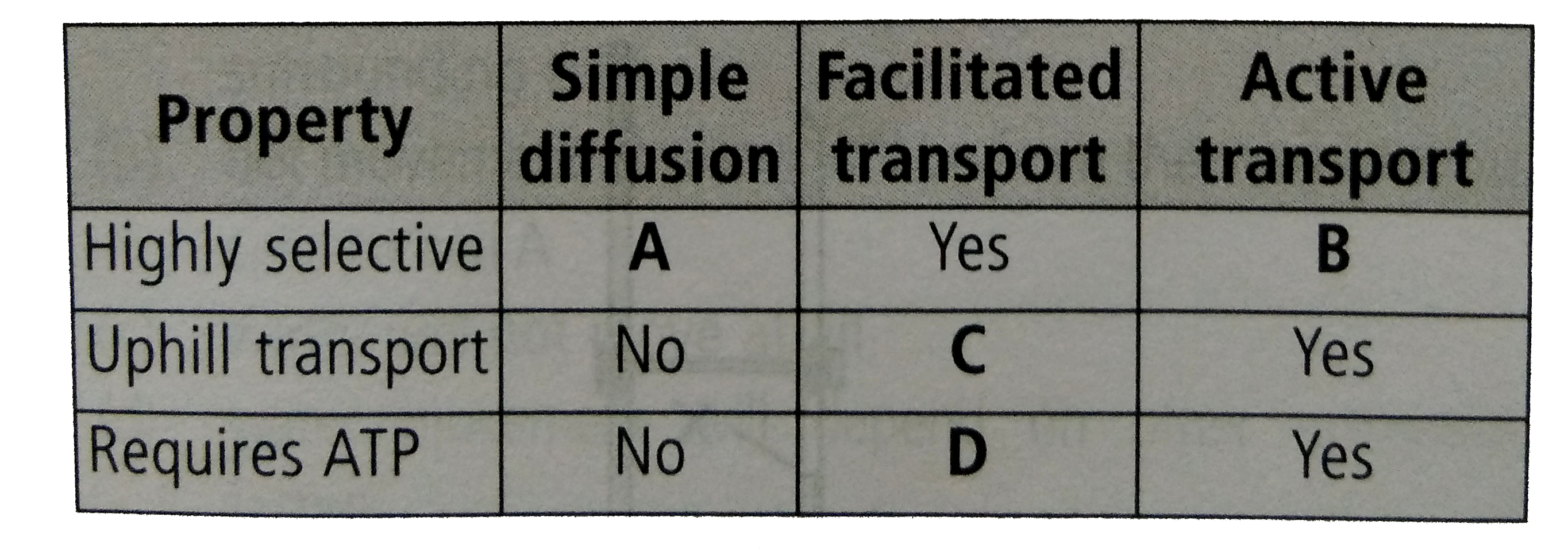 04:26View Solution
04:26View SolutionOsmosis is a special kind of diffusion, through which water diffuses across the cell membrane the rate and direction of osmosis depends upon
01:39View SolutionThe given table shows properties of four cell systems `A,B,C` and `D` the maximum rate of inward diffusion of water will be observed in which of these system ?
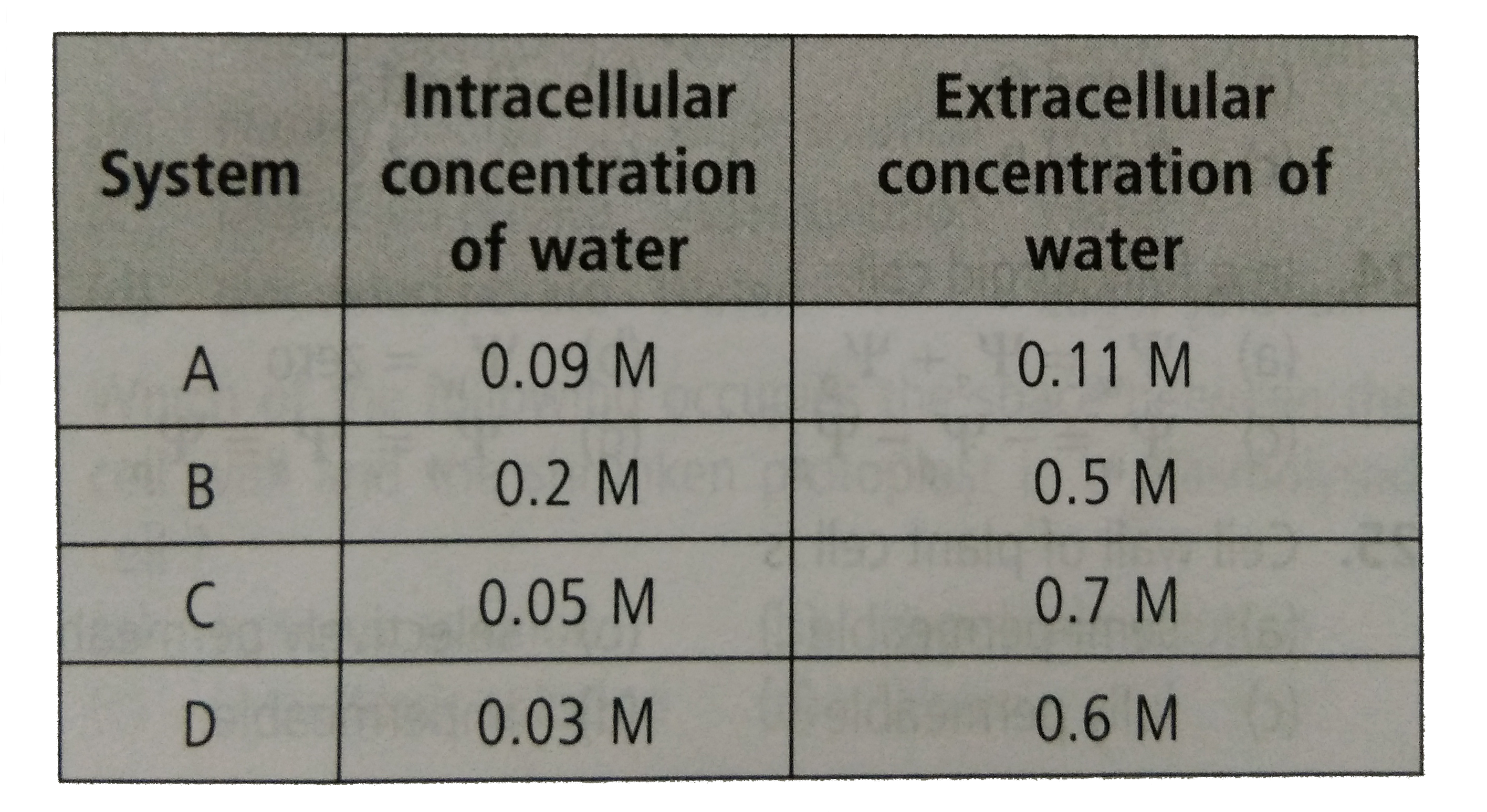 02:08View Solution
02:08View SolutionIf some solute is dissolved in pure water, its water potential
02:02View SolutionRead the following statements and select the correct option.
Pure water has the highest water potential,`i.e.` zero.
Process of diffusion does not require any input of energy.
Water moves from the system containing water at higher water potential to the one having lower water potential.02:43View SolutionIf `Psih_(w)=` water potential, `Psi_(s)=` solute potential, `Psi_(p)=` pressure potential then select the correct equation showing their inter-relation.
02:20View SolutionWater potential of a flaccid cell will be
03:08View SolutionWater passes into a cell due to
04:07View SolutionWhich out of the four plant cells `(P,Q,R "and" S)` would not exhibit any wall pressure?
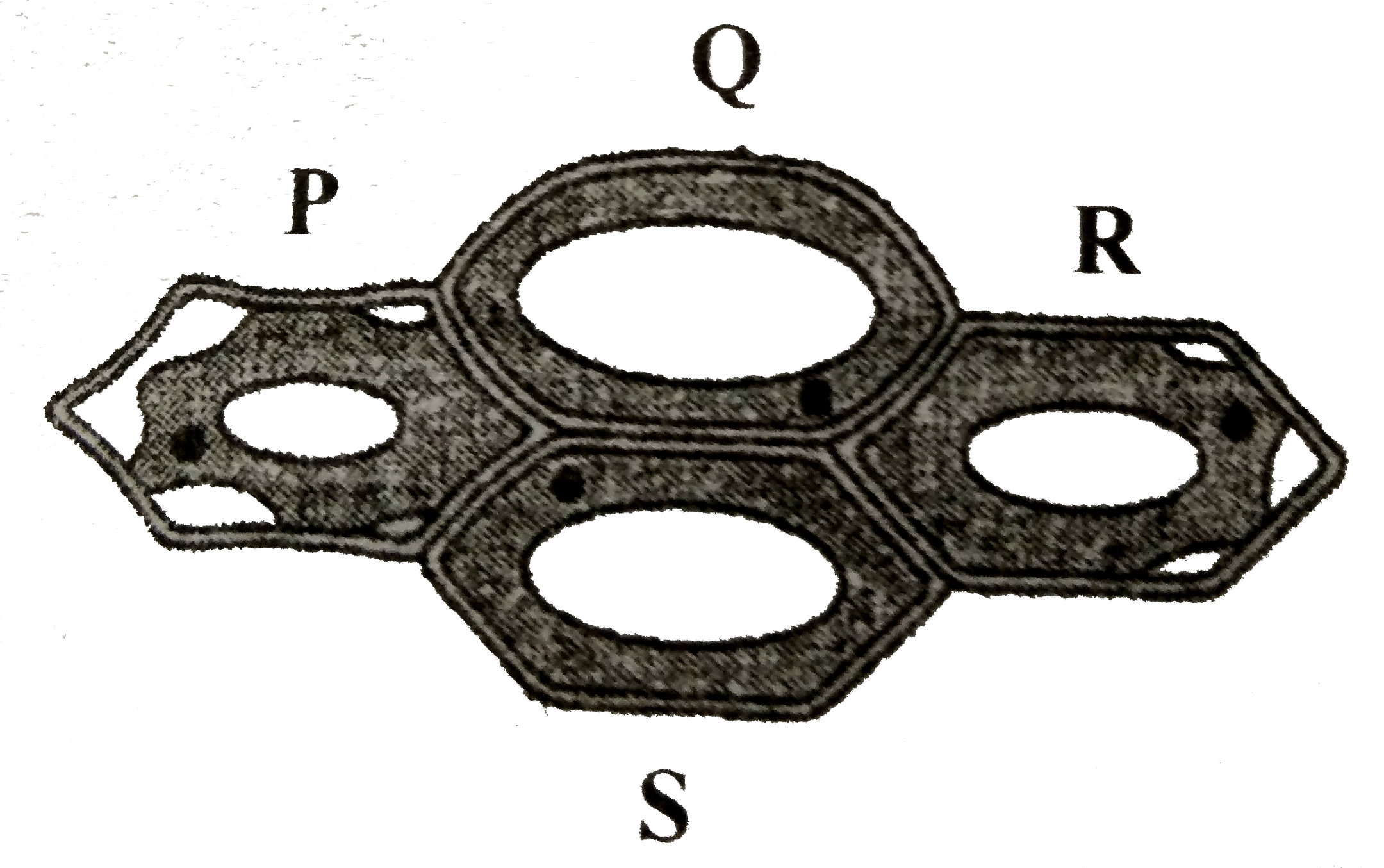 02:22View Solution
02:22View SolutionIn a fully turgid cell
03:19View SolutionCell wall of plant cell is
03:42View SolutionRead the given statements and select the correct ones.
`A` membrane which permits the passage of pure solvent molecules to pass through it and not the solute particles is called semi-permeable.
A membrane which allows some substances to pass through it more readily than other is known as selectively`//`differentially permeable.
All living biological membranes are perfectly semi-permeable.03:14View SolutionWhich of the following biological membrane is semi-permeable?
02:06View SolutionThe plant cell cytoplasm is surrounded by both cell wall and cell membrane. The specificty of transport of transport of substances is mostly across the cell membrane, because
03:04View SolutionMovement of solvent molecule from a region of its higher concentration to a region of its lower concentration through a semi- permeable membrane is refferred to as
03:37View SolutionRefer to the given figure and select the correct statement.
 03:02View Solution
03:02View SolutionRefer to the given figure and select the correct option regarding this.
 02:31View Solution
02:31View SolutionGiven figure represents demonstration of osmosis by egg membrane osmoscope.
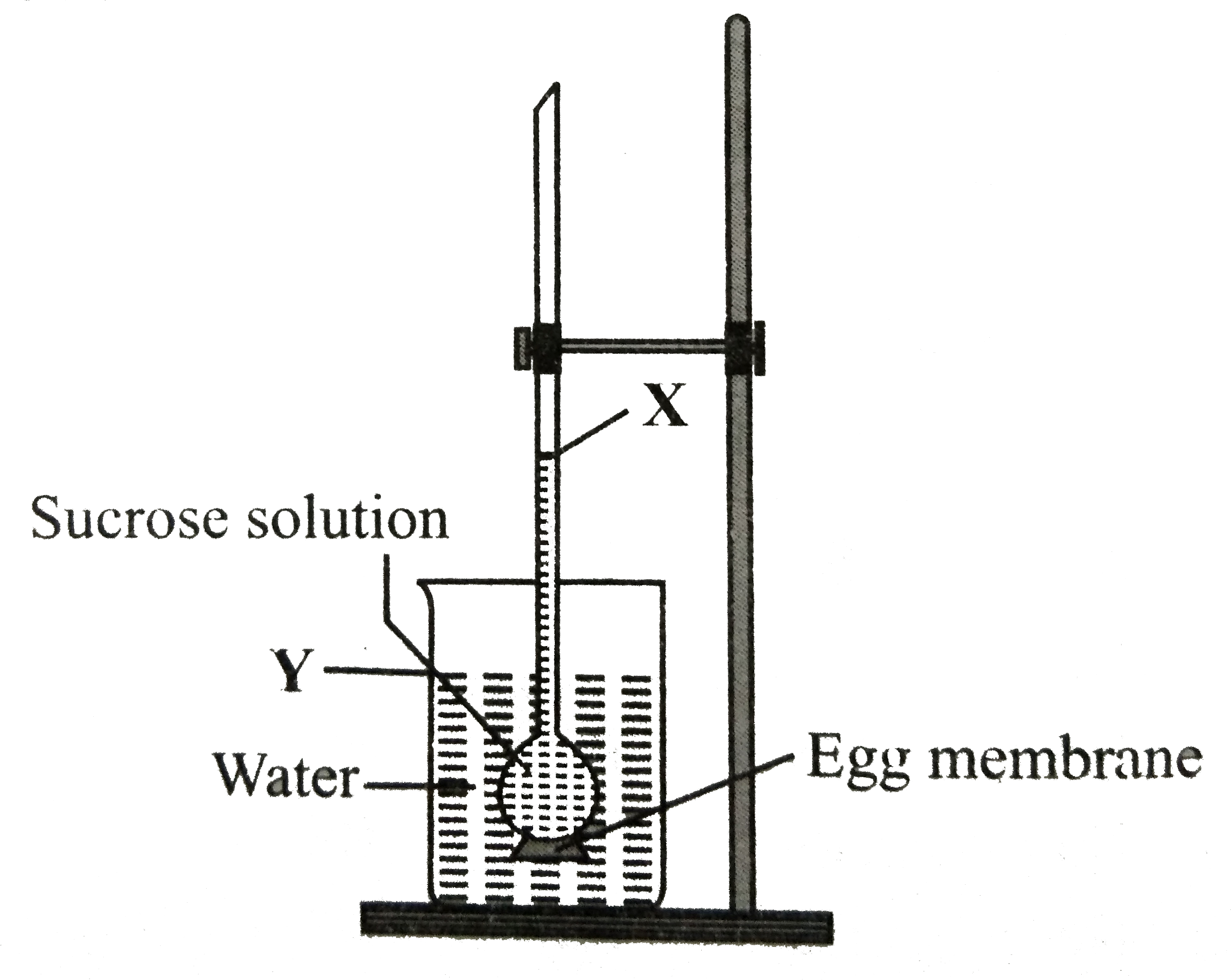
After few days which of the following would have occurred?02:34View SolutionIf `DPD` represents diffusion pressure deficit, `OP` is the osmotic pressure and `TP` is the turgor pressure then which of the following equations is coorect?
02:13View SolutionWater moves from a cell with `"____"DPD` to a cell with `"____"DPD.`
01:18View SolutionTwo adjacent cells `A` and `B` are being studied. Cell `A` has `OP` of `10` atm and `TP` of `6` atm. Cell `B` has `OP`of `10`atm and `TP` of `4` atm.
Movement of water will occur from02:23View SolutionIf a cell `A` with `DPD=5` bars is connected to cells `B,C` and `D` whose `OP` and `TP`are respectively `5` and `5,10` and `4` and `8` and `3` the flow of water will be
02:31View SolutionWhich option is true for a fully turgid cell ?
02:24View SolutionIf a cell `A` with `DPD 5` atm is surrounded by many cells with `DPD 4` atm then
02:05View SolutionThe cell `A` has an osmotic potential of `-20` bars and a pressure potential of `+6` bars. What will be its water potential?
01:05View SolutionThe given figure shows set up of potato osmoscope experiment. Select the option that correctly identifies the labels `A,B` and`C`
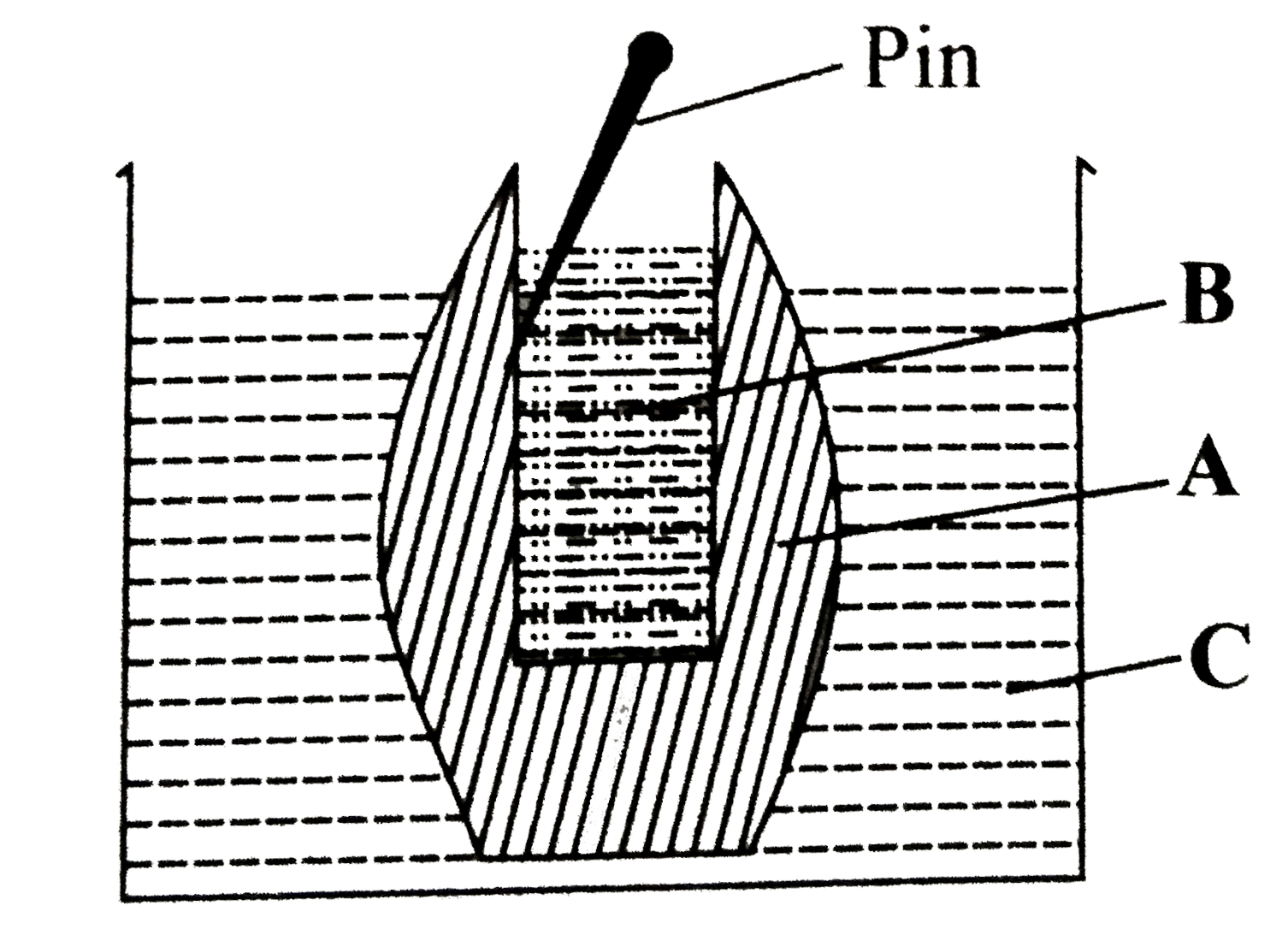 03:02View Solution
03:02View SolutionWhich of the following occupies the space between the cell wall and the shrunken protoplast in a plasmolysed cell?
02:37View SolutionMatch column `I`with column `II` and select the correct option from the codes given below.
`{:(,"ColumnI", "Column II"),(A,"Hypotonic","No net flow of water"),(B,"Hypertonic","(ii)Water moves into the cell"),(C,"Isotonic",(iii)Water moves out of the cell"):}`02:54View SolutionA flowering plant is planted in an earthen pot and irrigated. Urea is added in high amouts to make the plant grow faster but after same time the plant died. This may be due to `"_______"`
02:12View SolutionThe cocentration of solute in four cells is `0.4m.` They are placed in four separate containers `I,II,III` and `IV` filled with saline water of concentrations `0.1M,0.4M,2M` and `3M`respectively. In container will the cell swell?
02:40View SolutionUse of excessive fertilisers causes wilting due to
01:50View SolutionTo initiate cell plasmolysis, the salt solution should be
02:02View SolutionSalt is added to preserve meat pickles etc. because salting kills bacteria by the process of
01:37View SolutionRefer to the given figure and identify cell `A,B`and `C`.
 02:12View Solution
02:12View SolutionStatement`: Plant cells do not rupture when placed in distilled water.
Statement 2: Animal cells rupture when placed in distilled water01:34View SolutionStatement `1:` Plasmolysis is bursting of cell membrane when a cell is kept in a hypertonic solution.
Statement`2:` Hypertonic solution causes endosmosis.02:18View SolutionA plasmolysed cell can be deplasmolysed by placing it in
02:14View SolutionThe restoration of turgidity is a plasmolysed cell when placed in a hypotonic solution is caused by
01:58View SolutionRead the given statements that refer to different stages of plasmolysis. Select the correct option regarding them.
`(i)` First stage of plasmolysis, when osmotic concentration of cell sap is just equivalent to that of external solution.
`(ii)`
Protoplast withdraws itself from corners of hte cell wall
Protoplast gets detached from the cell wall and attains a spherical shape.03:05View SolutionPressure exerted by cell wall to balance turgor pressure is called
02:07View SolutionThe hydrostatic pressure developed inside the cell on the cell wall due to endosmosis is called
01:59View SolutionAbsorption of water from soil by seeds increases the `"_______"` thus helping seedings to come out of soil.
03:33View SolutionWhich of the following statements is correct ?
02:56View SolutionThe practice of breaking of rocks during rainy season by inserting wooden pegs in them is based on the phenomenon of
01:59View SolutionWhich of the following statements is correct?
03:23View SolutionSelect the incorrect statement regarding imbibition.
02:58View SolutionStatement 1: It becomes difficult to open and shut the wooden doors and windows during rainy season.
Statement 2: Wooden doors and windows imbibe water in rainy season and thus their volume is increased.02:06View SolutionThe most important factor for absorption of water in plants is
02:01View SolutionThe given figure shows three different types of pathways of intercellular movement of water in plants indentify `A,B` and `C` and select the correct option.
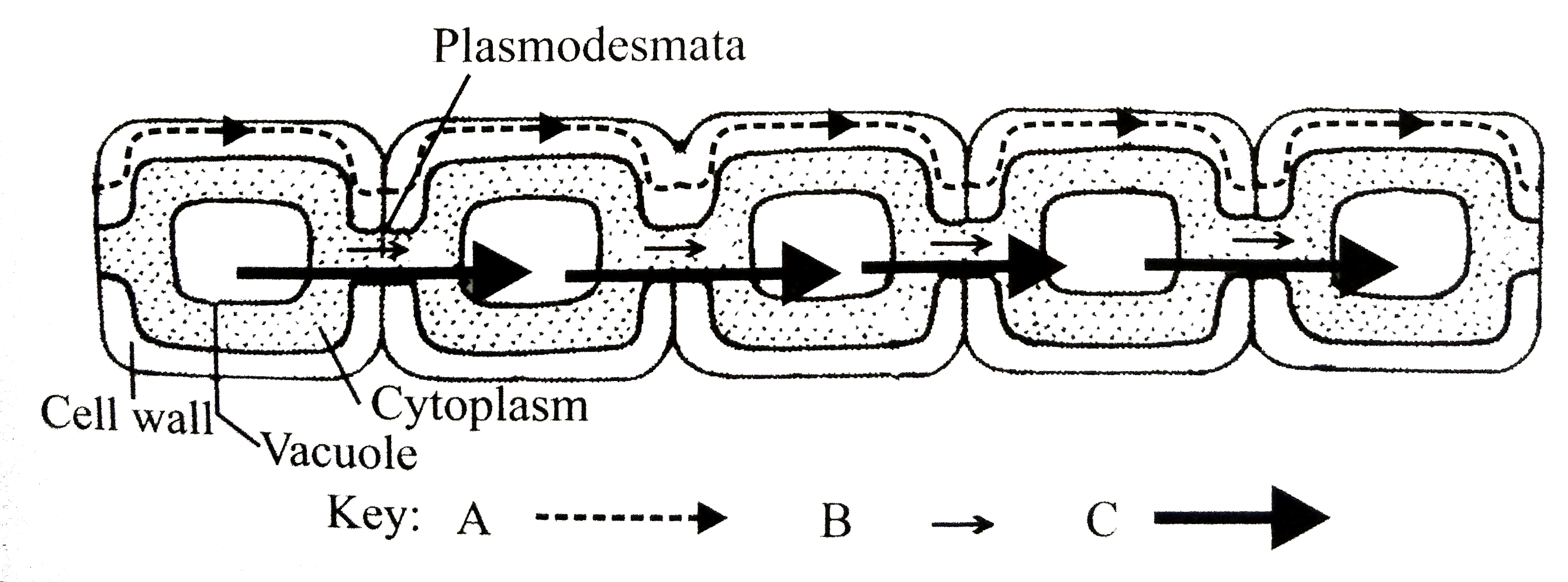 03:23View Solution
03:23View SolutionIn apoplast pathway water moves exclusively through the
01:35View SolutionIn which of the following pathways, movement of water occurs from one cell to another cell through plasmodesmata?
03:38View SolutionFollowing are the differences between apoplast pathway and symplast pathway.
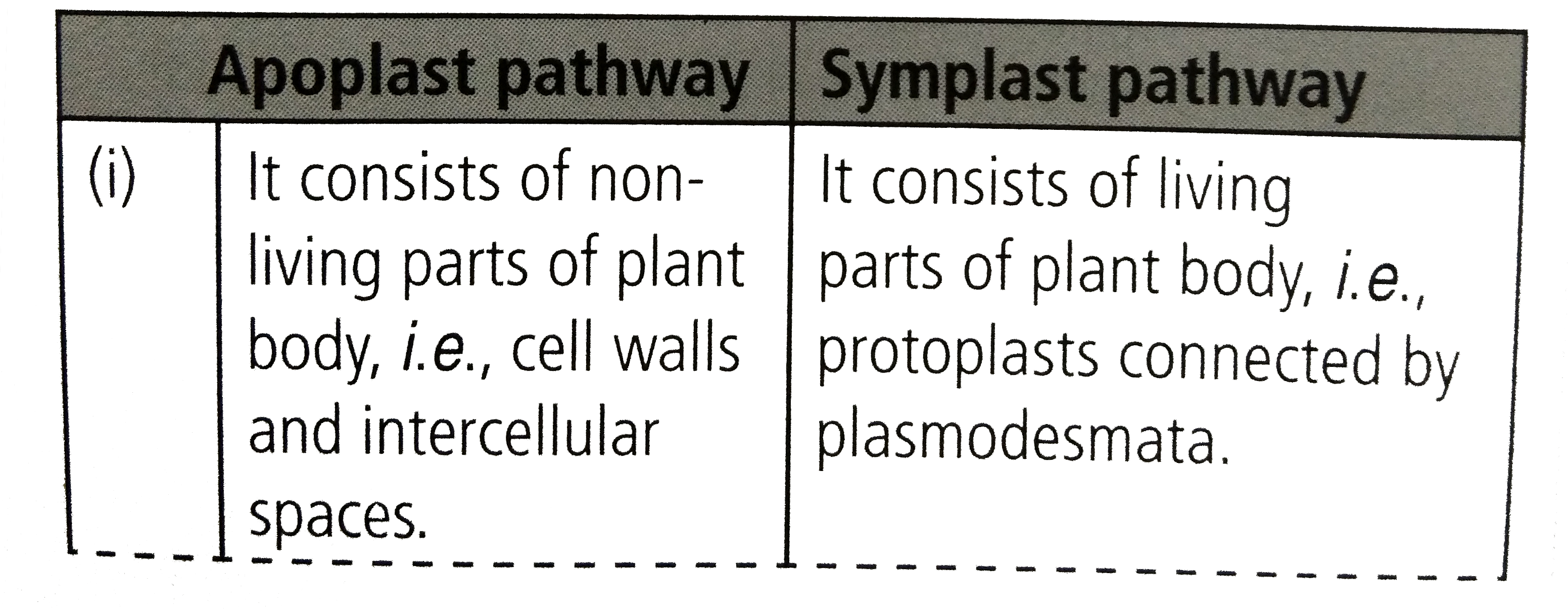
 04:07View Solution
04:07View SolutionIn `"________"` pathway, water crosses atg least two membranes for each cell in its path `i.e.,` plasma membrane on entering and ecxiting).
02:27View SolutionIn the given flow chart the flow of water is shown from soil to xylem of the root. Identify the tissues involved in steps `A` nad `B`
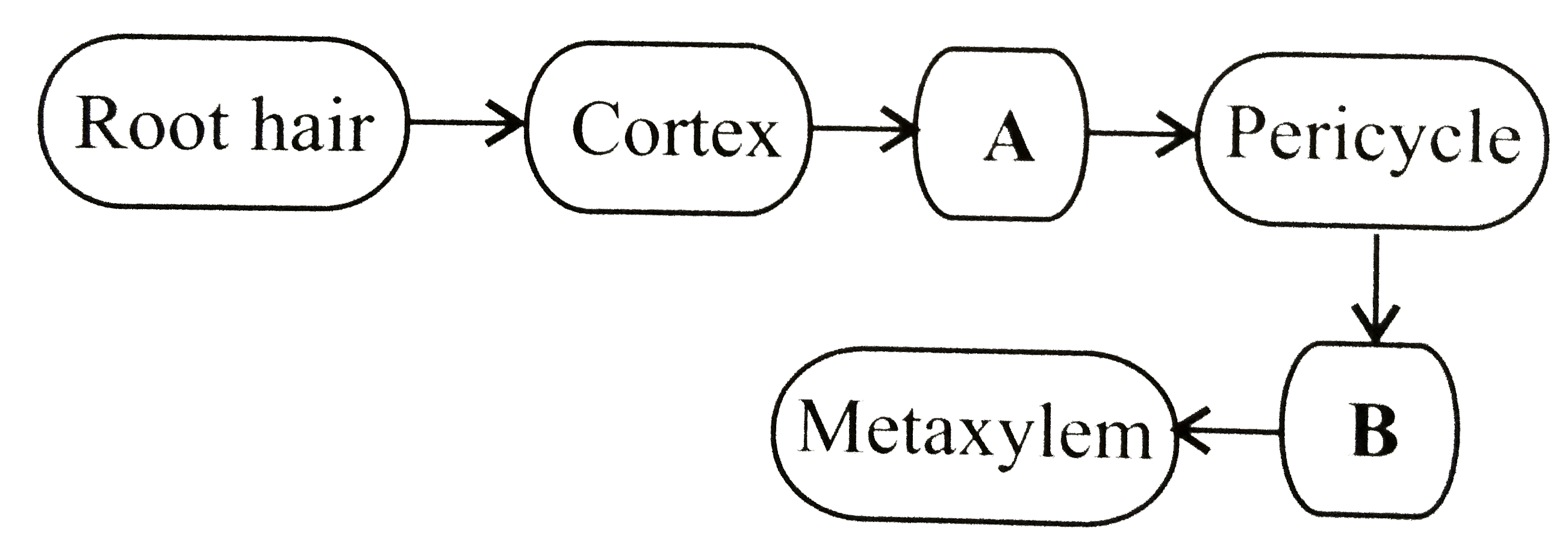 02:50View Solution
02:50View SolutionWater will move from the root hair through cortex if the water potentials are
02:45View SolutionRefer to the given figure Identify the labelled parts `(A-H)` and select the correct option.
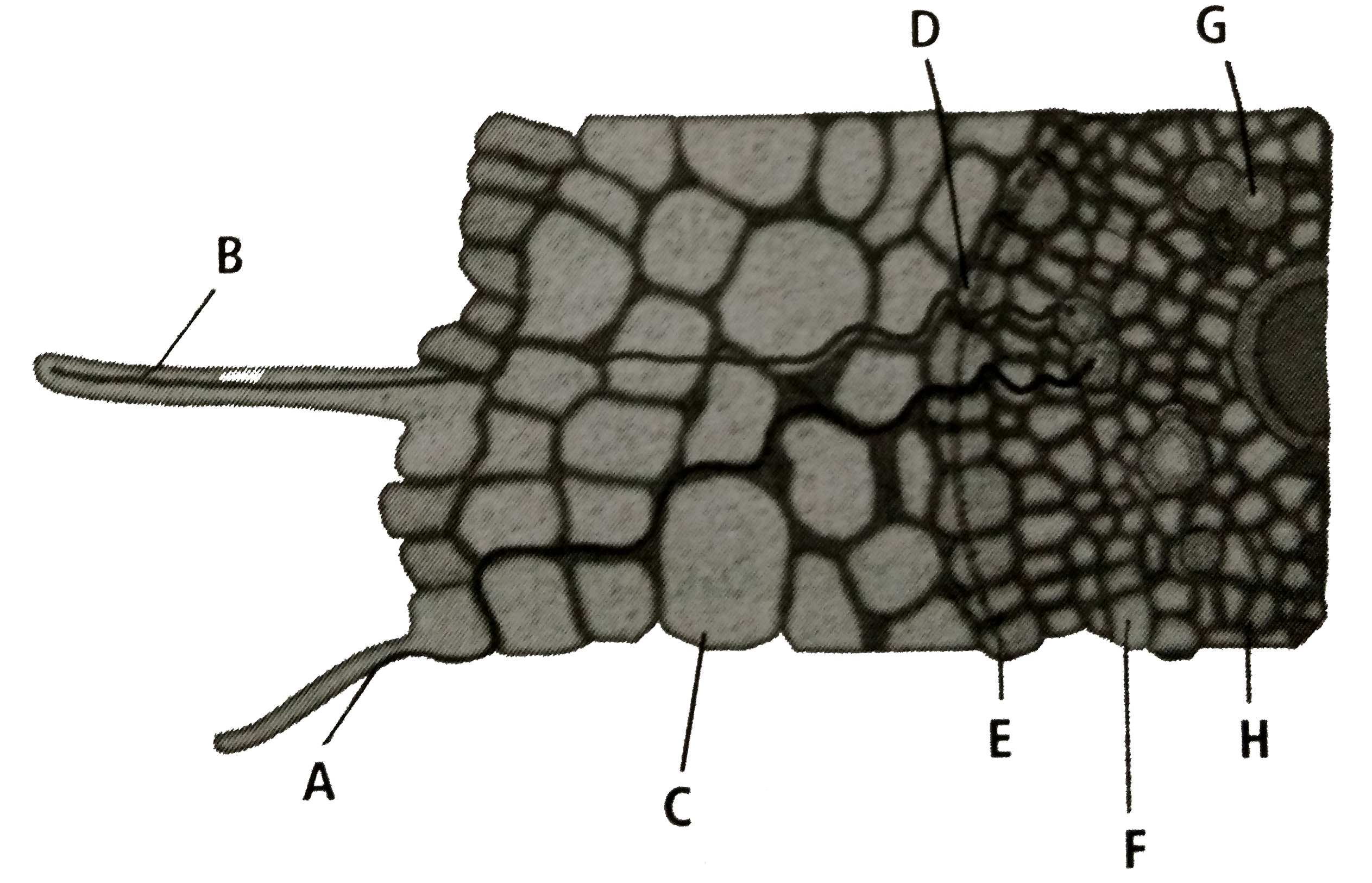 02:43View Solution
02:43View SolutionIn submerged hydrophytes, the absorption of water takes place through
01:19View SolutionIf a soft stemmed plant is cut horizontally near the base of its stem with a sharp blade on early morning of a humid day, drops of solution ooze through cut stem. This is due to
03:07View SolutionLoss or excretion of water in the form of liquid droplets from the margins and tips of leaves is called
01:32View SolutionSelect the option which correctly satisfies the same relationship.
Stomata : Transpiration : : Hydathodes :`"_______"`02:13View SolutionWhich of the following statements is incorrect?
03:03View SolutionAscent of sap is best explained by
02:25View SolutionThe transpiration-driven ascent of xylem sap depends mainly upon`"______"` property of water.
02:17View SolutionLoss of water in the form of vapours from the living tissues of aerial plant parts is called
02:22View SolutionRefer to the given figure
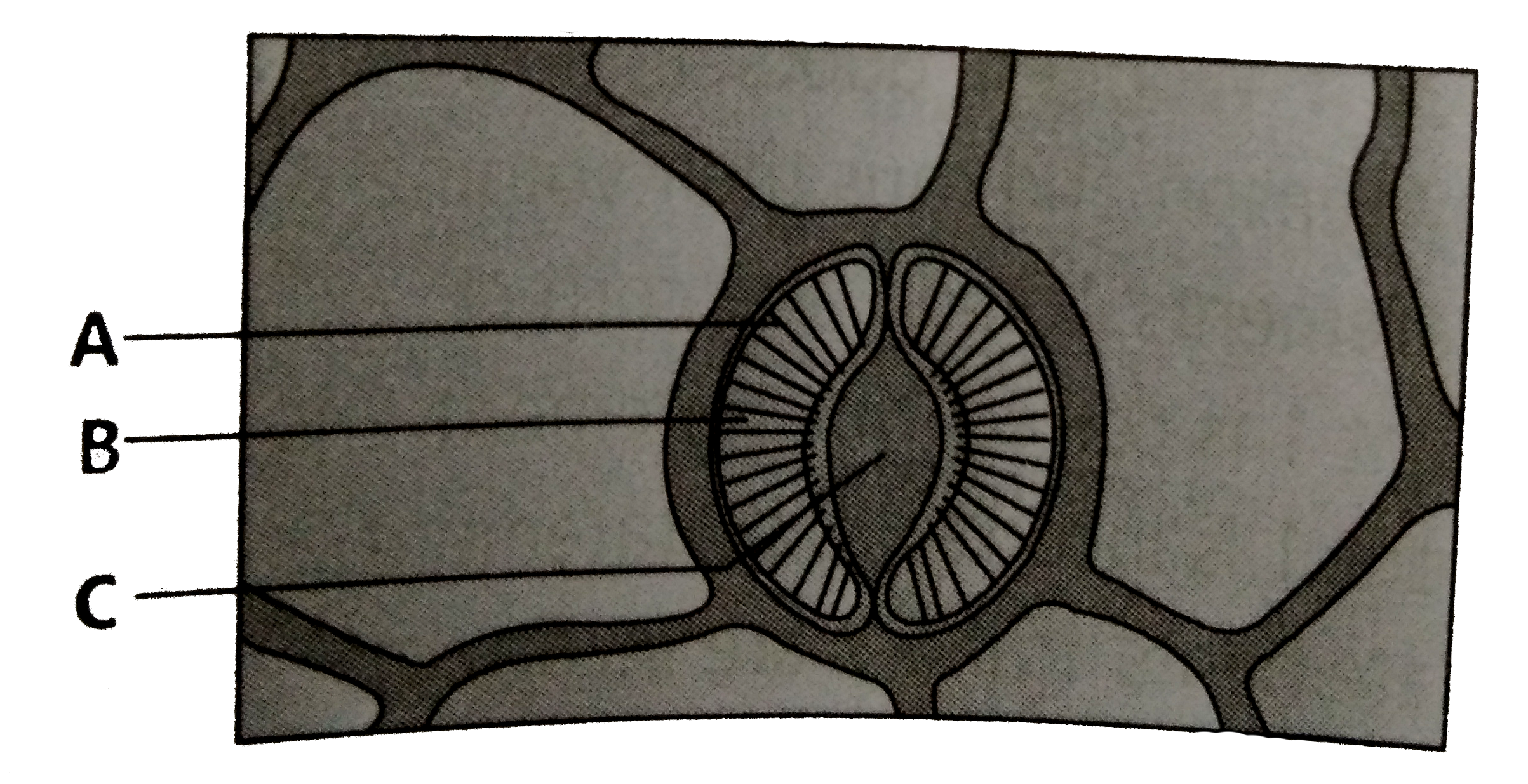
Select the correct statement regarding the labelled parts `A-C`03:15View SolutionAmphistomatic leaf with stomata distributed equally on both the surface is an example of
02:50View SolutionThe given figure shows two states of a stomata
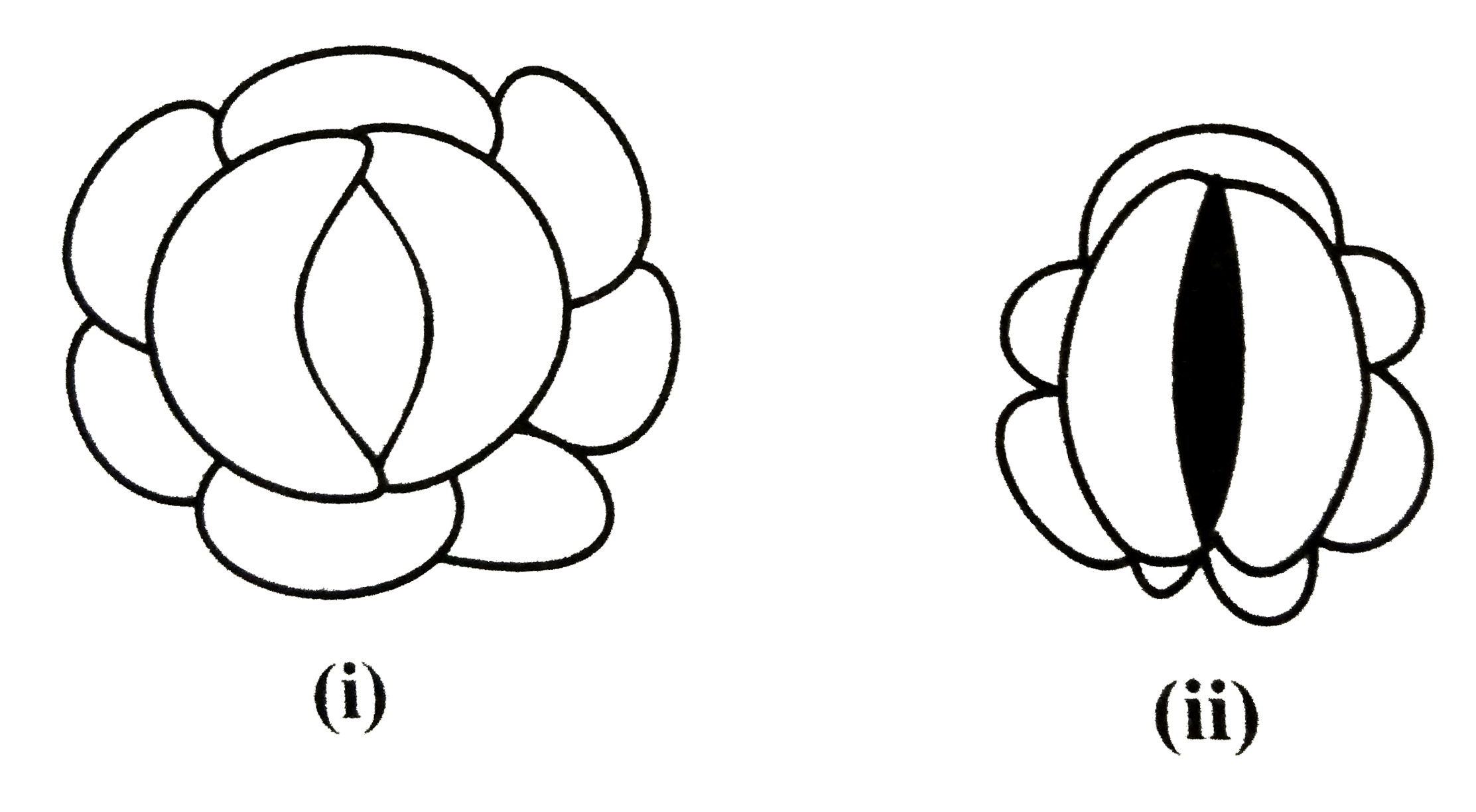
In which of the conditions `(i)` and `(ii)`, guard cells will have higher water content?02:06View SolutionRefer to the given figure and select the option which correctly identifies `A,B` and `C`
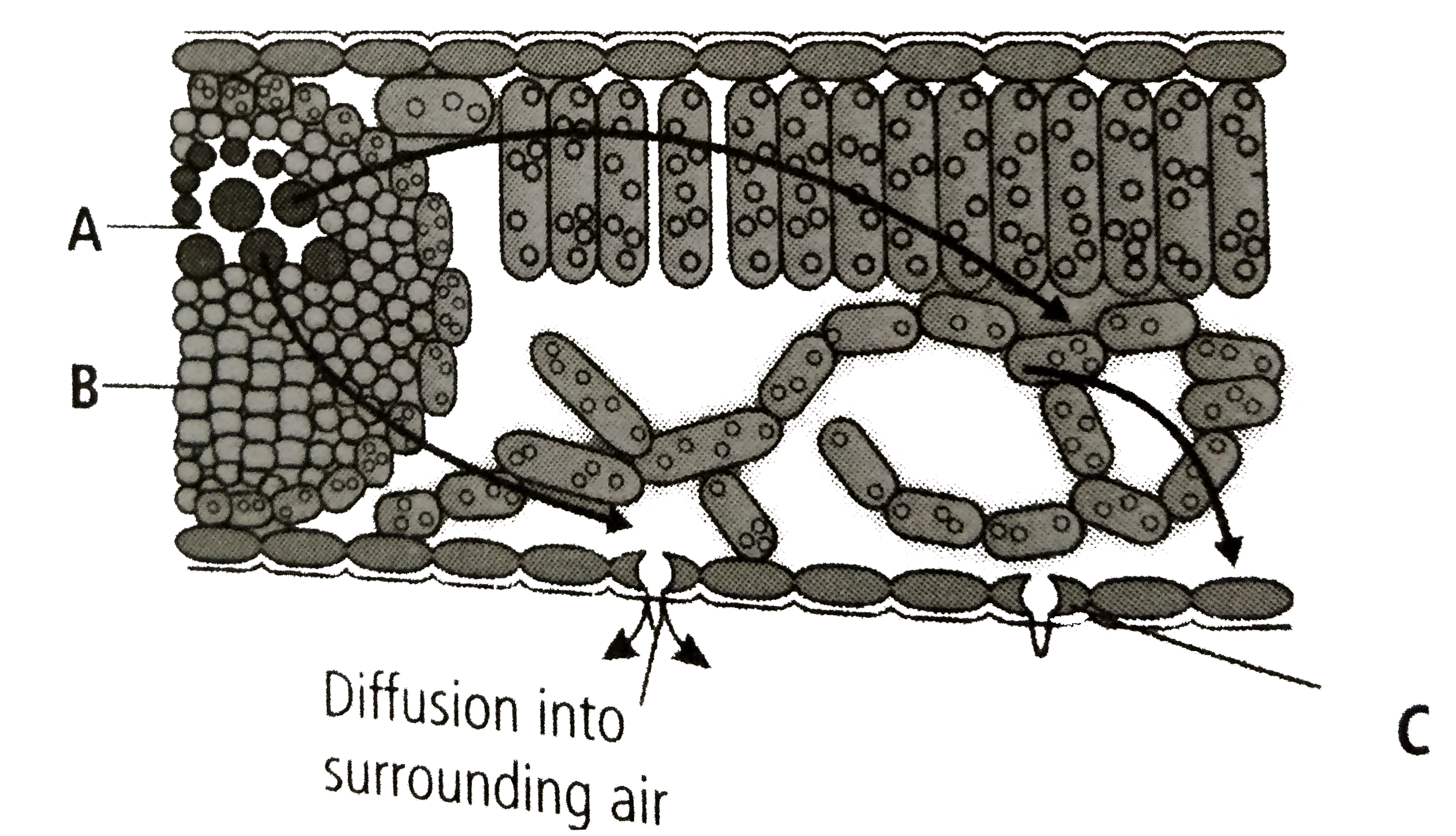 01:53View Solution
01:53View SolutionMatch column`I` with column `II` and select the correct option from the codes given below.
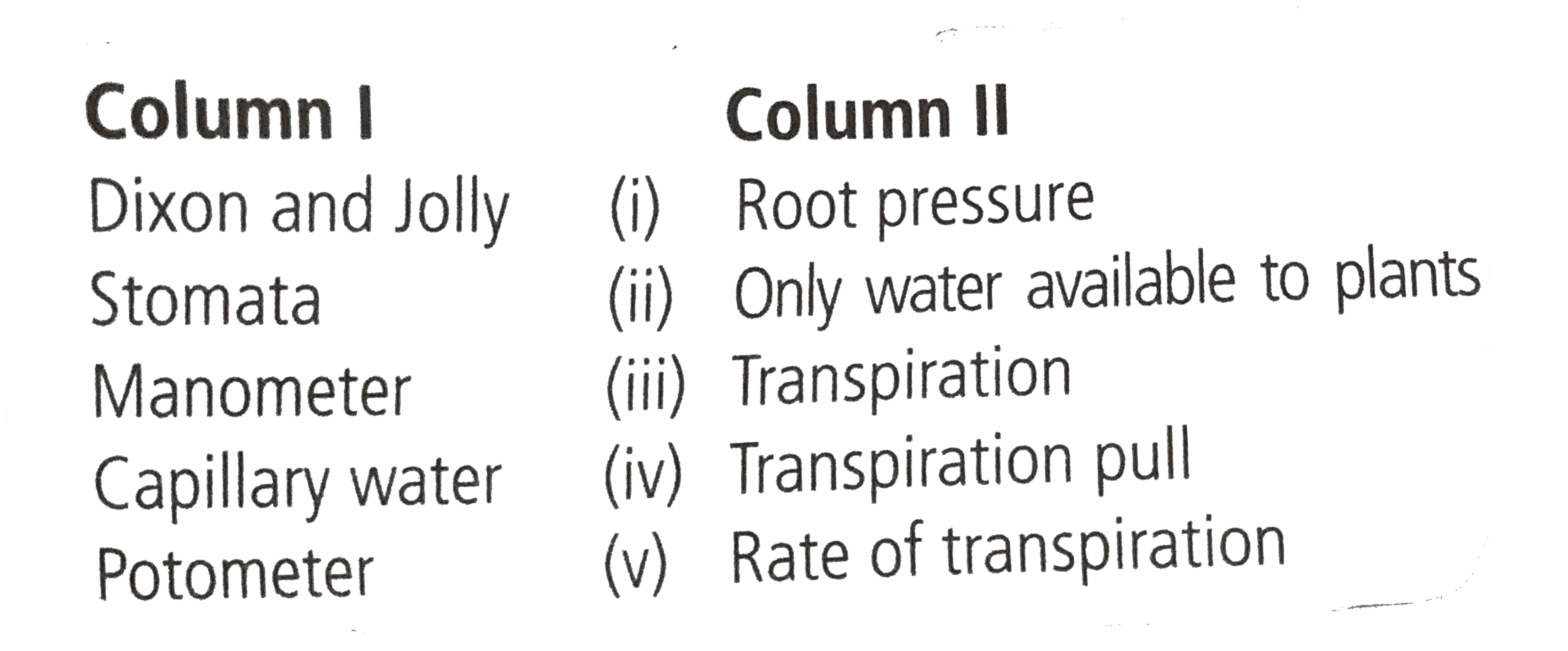 02:20View Solution
02:20View SolutionWater moves up against gravity and even for a tree of `20m`height the tip receives water within two hours . The most important physiological phenomenon which is responsible for the upward movement of water is `"______"`
02:17View SolutionThe bulliform cells of leaves lose their turgidity during excessive
01:46View SolutionMatch column `I` with column `II` and select the correct option from the codes given below.
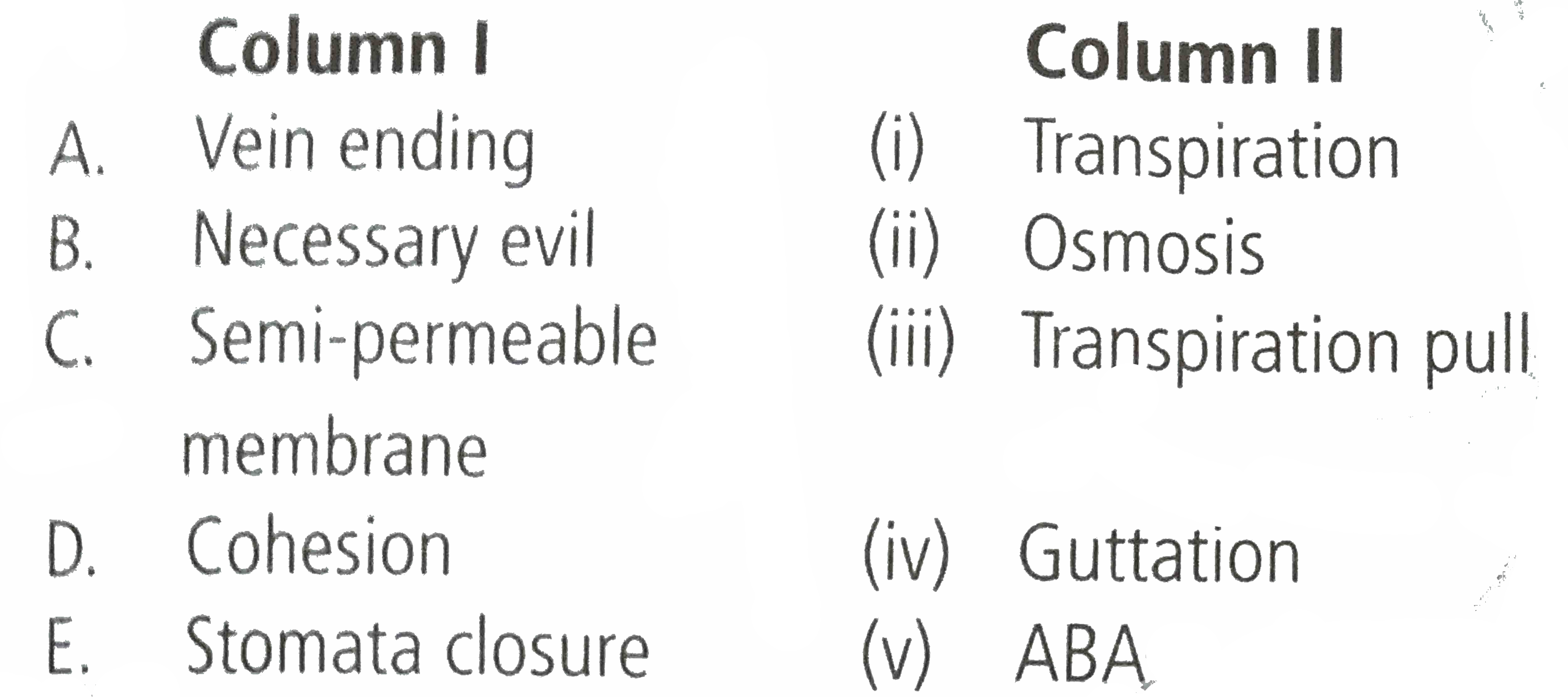 02:29View Solution
02:29View SolutionConcentration of minerals in the soil is usually `"______"` than the concentration minerals in the root.
01:52View SolutionWhich of the following statements is correct ?
02:39View SolutionWhich of the following elements are most readily mobilised?
02:12View SolutionStatement 1: Xylem transport is unidirectional.
Statement 2: Phloem transport is bi-directional.02:07View SolutionUnidirectional flow of water minerals, some organic nitrogen and hormones occurs through
02:12View SolutionThe manufactured food in a green plant moves from the leaves to other parts through
01:43View SolutionMulti-directional flow of a variety of organic and inorganic solutes occurs through
01:55View Solutionphloem sap is mainly made of
01:43View SolutionThe given diagram shows a potato plant forming new tubers.
Which route would be taken by most of the food at this time
 03:08View Solution
03:08View SolutionMass flow hypothesis was first described by
01:41View SolutionRefer to the given figure representing mechanism of translocation and select the option which correctly identifies `A.B` and `C`
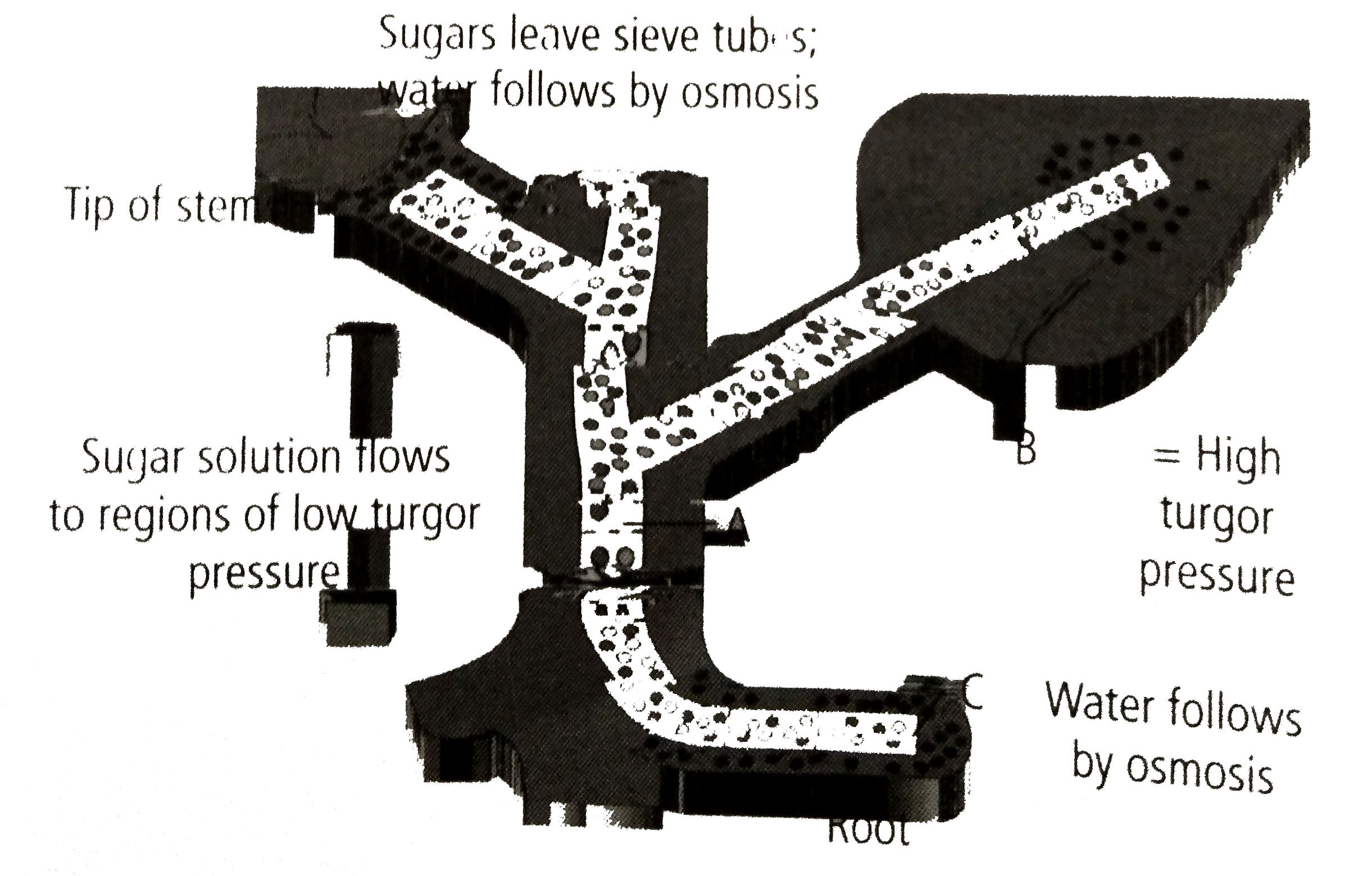 02:29View Solution
02:29View SolutionOrganic substances such as sugars are translocated in the phloem. It can be demonstrated by
02:38View SolutionA girdled plant (upto bast) may survive for some time but it will eventually die, because
01:40View SolutionRinging/girdling experiments demonstrate
02:06View Solution
Transport In Plants questions and complete solutions for chapter TRANSPORT IN PLANTS of MTG BIOLOGY (HINGLISH) of Class 11
